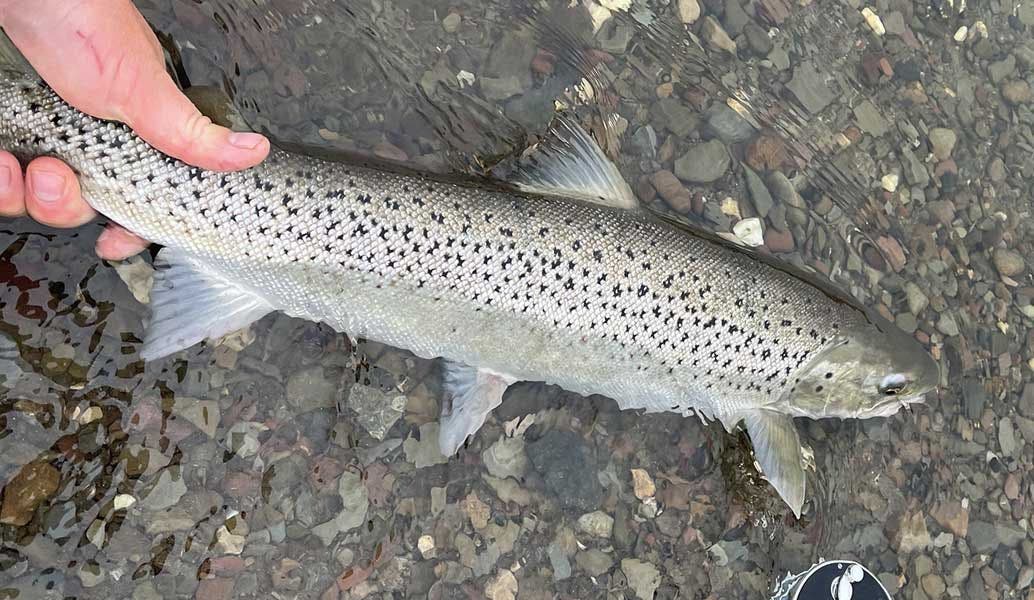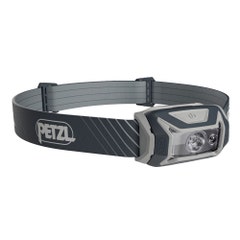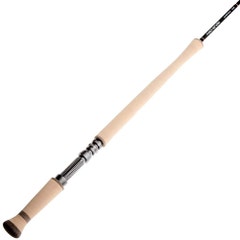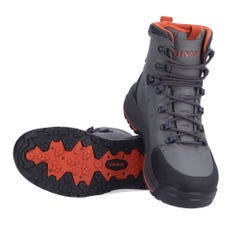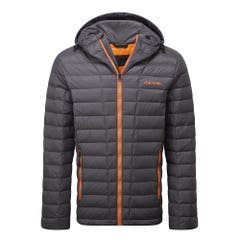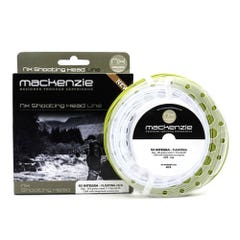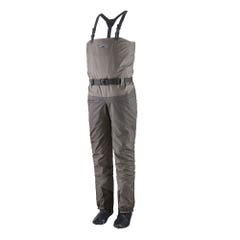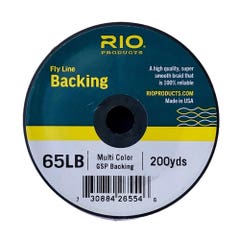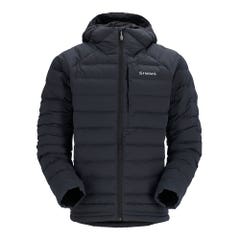That’s not to say it’s impossible to catch them in the day. For example, loch fishing is a daytime activity undertaken from drifting boats casting teams of wet flies in front of the boat. To work well a steady breeze is needed coupled with an overcast sky. They can also be caught in high, coloured water on spinners and large flies. Fishing low clear water with nymphs and dry flies can also be succesful. So night fishing is just one option, but when conditions are right it can turn a shy retiring fish into an aggressive taker!
 A nice sea-trout from Woodmill Pool - River Itchen
A nice sea-trout from Woodmill Pool - River ItchenLet’s look at tackle for night-time fly fishing:-
Rods A 10’ 7wt fly rod is considered the norm for night fly fishing on medium to large rivers. The ideal fly rod should have a medium action to allow plenty of feel for casting in darkness and for giving the best chance of maintaining a delicate hook hold on a fresh soft mouthed fish. The rod also needs adequate backbone to play powerful fish. Fast action rods can be slowed down by putting a line size too heavy on them. If you are fishing a large river with limited back-casting space you may find a switch rod useful – the extra rod length will help lift the line over a high bank or allow easy speycasting.
Reels Big sea-trout are powerful and fast moving so a large arbor, disc drag fly reel is perfect. The fast retrieve will keep you in touch with a fish moving at speed towards you and the smooth drag will iron out any sudden surges as the fish takes off on an unstoppable run.
Lines It pays to have a few fly line options – the exact densities you will need will depend on the depth of the river you are fishing and the speed of the flow. You will need to fish the surface, the bottom and depths in between.
Leaders My preference is for standard nylon leaders – this material is easy to knot, strong and reliable. At night there is no need to fish fine so 8-15lb b/s is correct depending on the size of the flies you will cast and the fish you expect to catch.
Flies Your choice of sea-trout flies will depend on where you are fishing. But you can’t go wrong with black and silver patterns – singles, doubles, tubes, waddingtons, tandems plus a few surface lures.
Net It pays to carry a sea-trout fishing net big enough to engulf the biggest sea-trout you are likely to catch. A useful tip is to paint the leading edge of the nets frame white so you can see it easily in the darkness.
Clothing and Waders Even in the middle of summer it can get really cold on the riverbank in the early hours of the morning. If you are tired and cold your warm dry bed will look very attractive and you could easily miss the most productive part of a night’s fishing. So dress in layers, with good quality waders and wading jacket as an outer shell. Always have a flask with a hot drink at hand and dry clothes in the car in case you fall in.
 Begin sea-trout fishing as the light fades
Begin sea-trout fishing as the light fadesPlan Your Nights Fishing!
Here’s a rough plan for your night’s fishing. The golden rule is always to spend some time checking out the beat before you start to fish. The river will look and feel very different in darkness so it pays to become as familiar as you can in daylight. Look for places to enter and exit the river if you intend to wade (mark them with a stick) – also for landmarks on the skyline near to promising fishing spots. You may also find shoals of fish, note where you see them, although in darkness lies may change particularly if running fish are about entering and leaving the pools.
Start to fish fast water as the light begins to fade – the rippled surface will obscure you from the fish and you may catch a bonus grilse or salmon. I would use small flies at this time (a pair of small doubles – a silver stoat and a silver invicta would be good choices size 10 – 14). I would continue with these until it is fully dark. At this time start to look for deeper slower water particularly with some tree cover and spend a further hour or so fishing with larger flies. By now it should be heading towards midnight and time to try a surface lure. Continue with this until it gets colder – very often the river will go quiet – have a rest and a hot drink then set up your rod with a sinking line and a big fly. The aim is to fish this deep and find some fish lying deep in a pool.
When the light starts to come up it’s time to revert back to the smaller flies to fish into the dawn.
None of this is set in stone and a lot depends on the how cold it gets and the river you are fishing but it’s a great starting point.
Not everyone will enjoy night fishing for sea-trout but it’s something every game angler should try. I promise it’s a great experience with a special charm for anyone who enjoys solitude and wild places.
Sea trout are an enigmatic quarry worthy of considerable effort on the part of the angler and this will probably involve some loss of sleep! There is no doubt that night fishing will give the best chance of success when the river is at a normal summer level. That’s not to say it’s impossible to catch them in the day.
For example, loch fishing is a daytime activity undertaken by drifting boats casting teams of wet flies in front of the boat. To work well a steady breeze is needed coupled with an overcast sky. They can also be caught in high, coloured water on spinners and large flies. Fishing low clear water with nymphs and dry flies can also be successful. Let's take a look at what sea trout tackle you may need:
Sea Trout Tackle Recommendations
Rods for Sea Trout Fishing
A 10’ 7wt fly rod is considered the norm for night fly fishing on medium to large rivers. The ideal fly rod should have a medium action to allow plenty of feel for casting in darkness and for giving the best chance of maintaining a delicate hook hold on a fresh soft mouthed fish. The rod also needs an adequate backbone to play powerful fish.
Fast action rods can be slowed down by putting a line size too heavy on them. If you are fishing a large river with limited back-casting space, you may find a switch rod useful – the extra rod length will help lift the line over a high bank or allow easy spey casting.
Reels for Sea Trout Fishing
Big sea trout are powerful and fast moving so a large arbor, disc drag fly reel is perfect. The fast retrieve will keep you in touch with a fish moving at speed towards you and the smooth drag will iron out any sudden surges as the fish takes off on an unstoppable run.
Sea Trout Fishing Lines
It pays to have a few fly line options – the exact densities you will need will depend on the depth of the river you are fishing and the speed of the flow. You will need to fish the surface, the bottom and depths in between.
Leaders for Sea Trout Fishing
My preference is for standard nylon leaders – this material is easy to knot, strong and reliable. At night there is no need to fish fine so 8-15lb b/s is correct depending on the size of the flies you will cast and the fish you expect to catch.
Sea Trout Flies
Your choice of sea trout flies will depend on where you are fishing. But you can’t go wrong with black and silver patterns – singles, doubles, tubes, waddingtons, tandems plus a few surface lures.
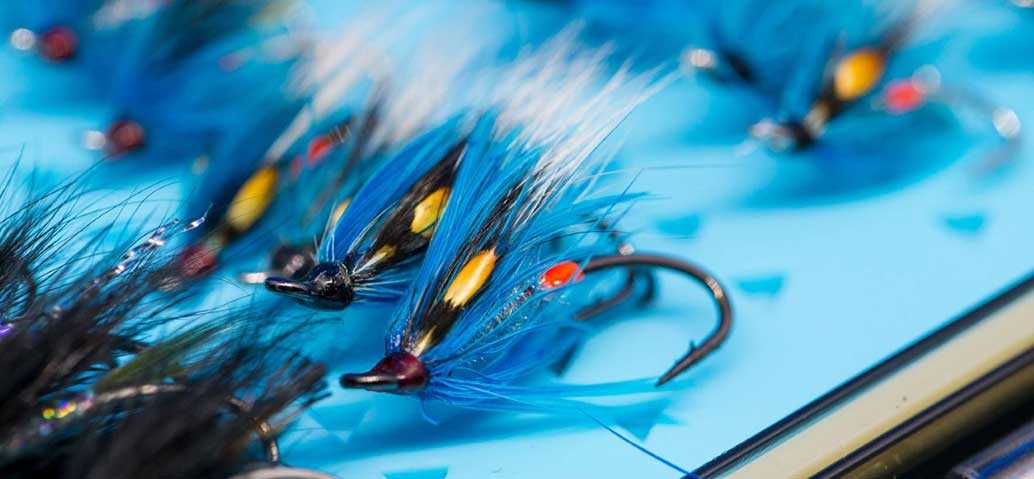

Fishing Net
It pays to carry a sea trout fishing net big enough to engulf the biggest sea trout you are likely to catch. A useful tip is to paint the leading edge of the net frame white so you can see it easily in the darkness.
Clothing and Waders
Even in the middle of summer, it can get really cold on the riverbank in the early hours of the morning. If you are tired and cold your warm dry bed will look very attractive and you could easily miss the most productive part of a night’s fishing. So wear layers, with good quality fishing waders and a wading jacket as an outer shell. Always have a flask with a hot drink at hand and dry clothes in the car just in case.
Fishing Accessories
A wading staff, life jacket and head torch with the option of a red filter to help maintain your night vision as well as to prevent spooking fish are all necessities.
Plan Your Night Fishing
Hardened sea trout anglers are often vampire-like in their habits as they only tend to venture out at night and, while it’s quite true that we catch most of our fish on those short, balmy summer nights, much of the essential preparation is done during the hours of daylight and it is arriving on your chosen beat before dark that can really make the difference to your results.
The work you need to do before the ‘lights go out’ is very much geared towards reconnaissance and this is particularly important if you are fishing a beat that you’re not familiar with. The golden rule is to always spend some time checking out the beat before you start to fish. You need to be familiar with the layout of the river in respect of where the pools are, where the shallower glides and current changes are and those areas where you can safely wade and land fish. You also need to have a good idea of where the trees and vegetation that might restrict your casting are.
 Begin sea-trout fishing as the light fades
Begin sea-trout fishing as the light fadesThe river will look and feel very different in darkness so it pays to become as familiar as you can in daylight. Look for places to enter and exit the river if you intend to wade (mark them with a stick) – also for landmarks on the skyline near promising fishing spots. You may also find shoals of fish, note where you see them, although in darkness lies may change particularly if running fish are about entering and leaving the pools so don’t become too fixated on any particular area
Start to fish fast water as the light begins to fade – the rippled surface will obscure you from the fish and you may catch a bonus grilse or salmon. I would use small flies at this time (a pair of small doubles – a silver stoat and a silver invicta would be good choices size 10 – 14). I would continue with these until it is fully dark. Remember too that your casting will naturally tend to speed up in the dark as you cannot see your line and this can lead to slack line in the stroke. To combat this, lighten your grip and try to feel for the rod tip being pulled by your line as it extends – that is your signal to commence the opposite stroke. At this time start to look for deeper slower water, particularly with some tree cover and spend a further hour or so fishing with larger flies.
As it gets darker start to explore the tail of the pool then later still work the deeper water with a larger fly, fishing it more slowly and working various depths, with an intermediate or sinking line. By now it should be heading towards midnight and time to try a surface lure. Continue with this until it gets colder – very often the river will go quiet – have a rest and a hot drink then set up your rod with a sinking line and a big fly. The aim is to fish this deep and find some fish lying deep in a pool.
In the pre-dawn revert to your dusk tactics – it’s only a short window of opportunity, but it can be a very productive time. When the light starts to come up it’s time to revert to the smaller flies to fish into the dawn.


None of this advice is set in stone and much of it can depend on how cold it gets and the river you’re fishing, but it’s a great starting point. Remember that you can catch sea trout during the daylight, indeed the UK is one of the few countries where we tend to fish for them almost exclusively at night and high water will certainly increase your chances of a daylight fish.
Do take a look at a moon chart though and if you want to make the most of night fishing avoid the full moon and select a dark phase as you cannot always rely on cloud cover to be your friend.
Sea trout fishing is often seen as a difficult and mysterious branch of fly fishing but with a little thought and preparation it is incredibly rewarding – and as summer approaches we are heading into the peak season, so get out and give it a go!

